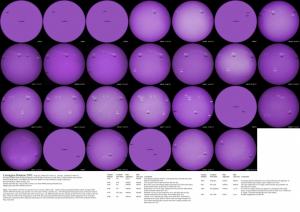Sunspot Summary Report for CR2093
Written by Howard Eskildsen
Start date: 2010/01/30, 19:56 UT, End date: 2010/02/27, 04:04 UT.
Notes: This rotation is the first in a long time to have no days without spots. I started writing Carrington Rotation reports in August 2007 with CR 2060 (34 rotations ago) and this is my first report without a spot-free day. AR 1043 appeared during the last day of the prior rotation and enlarged for a time, then faded while others took its place. On 100204 faculae from the remnants of AR 1040 were fully visible by the NE limb. Since AR 1040 was the reappearance of AR 1035, this marks the third time that this magnetic field has appeared on the solar disk. Further spots summarized below appeared and produced C-class and M-flares and spectacular prominences. Old Sol has awakened from its long, long sleep!
Sunspot Location Date Date
Number First Seen Appeared Last seen Comments
1043 NE xxxxx 100207 First appeared during CR 2092. It developed and crossed the disk, then faded as it rotated from view.
1044 NW 100205 100205 Tiny spot (per NOAA) that lasted less than one day.
1045 NE 100206 100213 Burst onto scene and enlarged rapidly and produced C and M class flares. It had started to decay by the time it rotated from view.
1046 NE 100206 100216 Rotated into view by NE limb, enlarged for a time and then faded before facular remnants rotated from view.
1047 SE Limb 100208 100209 Diminutive Cycle 23 spot rotated into view, then faded the next day. Faculae persisted, but slowly fated, until rotating from view.
1048 NE 100214 100216 Faculae were visible the day before on the solar limb. Prominences appeared on the nearby limb on 100214 and were bright enough to be seen without increasing the exposure time that is usually needed to see prominences in Ca-K.
1049 Southern 100217 100223 Its compact faculae rotated into view 5 days before the spot appeared. It remained distinct and complex until it rotated out of view.
Pore SE Limb 100218 100218 Tiny spot rotated into view in large, tenuous facular area, probably old decaying active region.
1050 SE Quadrant 100223 xxxxx New spot in compact facular area, adjacent to unrelated senile facular group. A huge filament extended from it to the SE limb, over 1 million km in length. It persisted through the end of the rotation.
Historic CR 2093 completed its cycle with spots present every day of the rotation. I started writing my CR reports with CR 2060 in August, 2007, and this is the first report I have done that did not have a spot-free day. Cycle 24 has arrived, yet strangely, there was a solitary Cycle 23 spot during this rotation.





